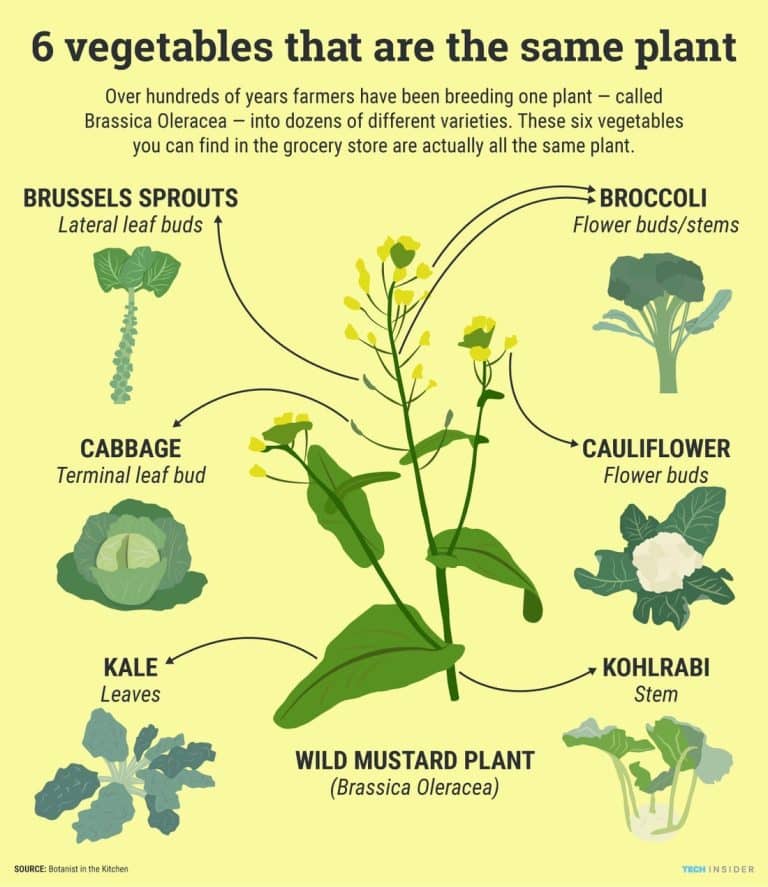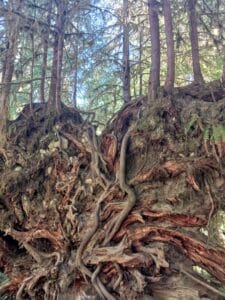
Plant, seed, and soil symbolism abound in holy writ. Seeds of faith may start out small, like a mustard seed, and then swell, enlarge, sprout and become delicious. Seeds may fall on various terrains that are more or less hospitable to germination. Small faith may grow powerful enough to move mountains. In some fields, desired plants and weeds may grow up together and require sorting at the period of harvest.
As anciently as 300 B.C.E., the wild mustard plant was cultivated into a variety of other vegetables. In the days of Christ, wild mustard had been cultivated into kale, collard greens, and Chinese broccoli. Today we also have cabbage, Brussels sprouts, cauliflower, broccoli, kohlrabi, and other varieties of cruciferous vegetables – all originating from Wild Mustard! – thanks to centuries of work by ingenious farmers and horticulturists.
Likewise, the small mustard-seed-sized particles of faith held by Latter-day Saints can develop into a variety of uniquely cultivated and contrasting belief structures. The seeds of faith that have been nurtured over time, given favorable terrain, and watered with ongoing attention will develop deep root systems and can grow to occupy significant space in the garden of belief.
In many cases, these seeds of faith are good seeds. When planted in nutrient-rich soil, and fed and watered with good intent, they can grow into plants that delight the senses, are delicious to the taste and very desirable.
Not all plants in the belief gardens of Latter-day Saints have grown from good seeds. Many bad seeds have been planted, tended, watered and have grown into huge, harmful, noxious multi-generational weeds. In this period of harvest, and in the planting of new gardens of belief in the minds of young people, Latter-day Saints must do more than cut back these overgrown plants of bad faith, we must dig out the roots and burn the ground so no future generations of the same bad seeds can ever swell or sprout again. We must water other good seeds to take over the ground in this place.
One seed of bad faith that has been watered and cultivated for over 100 years is the LDS racism of anti-blackness, colorism, and white superiority. For decades, church leaders taught that people of African descent were unqualified for ordination to the priesthood or to receive saving ordinances in the temple, which simultaneously limited the state of their exaltation in the Celestial Kingdom with God, according to the doctrine of salvation taught at the time. Members were also taught colorist beliefs about the skin tone of Indigenous Americans becoming lighter as they accepted the gospel and became more righteous. Generations of members received these teachings from their prophets, apostles and other revered leaders as God’s truth. Each time these teachings were reinforced by additional leaders, the seed of bad faith was watered until millions of current church members and their generations of pioneer ancestors had been exposed to this cultivar of the exclusivity of a racist and “whites-only” heaven. These teachings are a multi-generational poisonous plant in the garden of belief, grown from a seed of bad faith, and watered until they became strong, like unto other beliefs.
In her public facebook post describing how seeds of bad-faith racism were watered by perpetuating racist teachings in printed church materials, Dr. LaShawn Williams states: “Folks with ‘faith like a mustard seed’ in the belief that The Book & The Brethren were right that dark skin is a curse are sitting next to you and leading music and teaching primary and serving missions. That seed has been watered.”
Church leaders were wrong to preach these exclusive policies as ever being doctrine from God. My parents and grandparents and yours were wrong to believe it. For decades and generations, the seeds of bad faith grew into institutional and individual racism like an invasive, choking vine with poisonous darts. Our ancestors had faith in the teachings of church leaders for many positive and uplifting messages, even faith in their saving ordinances, so when these same church leaders comingled teaching racist beliefs with other gospel principles, it may have been difficult for our ancestors to differentiate what teachings to believe and which to abandon. Some of our own white ancestors may have been those leaders who preached racist ideologies. It can be challenging to see leaders as nuanced individuals with some right ideas and some very wrong ideas. Many members want the security of believing that the church is led by always-inspired, nigh-infallible prophets and apostles. Unfortunately, seeing the church leaders and members as rightly justified in their racial biases only serves to wrongly cast God as a discriminating, racist being, a notion that is irreconcilable with the fundamental truth of God being no respecter of persons.
We cannot accept that LDS teachings were merely just a “product of their time” or that nobody with the power to change them “knew any better.” Some people at the time DID know better, and acted better (though not perfectly). We observe in our sister-faith, the Reorganized Church of Jesus Christ of Latter Day Saints, (now Community of Christ) how Joseph Smith III received revelation to ordain men of every race in 1865, and in 1866 passed a resolution stating, “the Author of Life and Salvation does not discriminate among his rational creatures on account of Colour neither does the Church of Jesus Christ of Latter Day Saints.”
The Brighamite faction of the LDS church did not follow suit for more than 100 years, during which time the seeds of bad faith continued to stir up in the hearts of members around the world.
Thanks to the valuable work of Darius Gray and other members of the Genesis group, who advocated early-on for a reversal on the Priesthood and temple ban, the Official Declaration in 1978 to grant all priesthood and temple blessings without limitations to members of any ancestry was a crucial step in cutting back the overgrown racism that had run rampant in the belief gardens of the members. Church leaders began to backpedal their previously articulated folk doctrines and bad teachings by saying, “Forget everything that I have said” but neglected giving further instructions as to how to “unlearn” their previous teachings, as though small statements and pieces of paper were powerful enough to exterminate the plant that had such a tenacious generational grasp. In his famed 1996 interview on 60 Minutes with Mike Wallace, President Hinckley said of LDS racism, “It’s behind us. Look, that’s behind us. Don’t worry about those little flicks of history.”
It has been 24 years since President Hinckley called instances of LDS racism the “little flicks of history” and yet, still today in 2020, we regularly see signs that the eradication of the institutional and individual racism of LDS members has not been fully carried out. Racist interpretations of verses in the Book of Mormon were printed in church study materials this year, and official alternative explanations around the original text are still unsatisfactory. Some BYU students today (who most likely would have been born post-1978) are still broadcasting their racist beliefs, evidence of bad seed cultivars that have been watered and grown over the course of their lives. Retired BYU Professor Randy Bott was still perpetuating racist folk doctrines in his courses at BYU and in media interviews as recently as 2012, and despite disavowals of his teachings by church PR, was not removed from his teaching position until voluntary retirement and his call as a senior couple missionary with his wife.
Diminishing the magnitude of lingering systemic institutional and individual anti-Black and Indigenous racism as a “little flick” of history does not support the urgency of how badly we need anti-racist leadership and correction in our LDS teachings and rhetoric today. Minimizing the seriousness or depth of impact only serves to keep white members comfortable in their racial complacency and fragility.
Post-1978, what other strangleholds does this noxious vine of anti-Black and anti-Indigenous racism still have on the hearts of members? Without reconciliations or reparations for decades of faulty teachings, or official apologies to those marginalized by the policy as it stood, the Official Declaration does not work to cut out the roots or offshoots of protracted, multi-generational white supremacy peddled as God’s plan for His children.
In 2013, the Church published an essay about “Race and the Priesthood” – the first official acknowledgment that the ban was a product of “American racial culture” (i.e racism) and not “divine disfavor. The essay formally disavowed the past teachings which claimed doctrinal justifications for the ban. When asked for comments about issues that appear in LDS culture surrounding race, Church leaders and PR statements unequivocally condemn all racism, past and present. While these statements and documents are important components to a more racially literate membership, they do not go far enough to help individual members address or retrain their engrained racial biases. Many members are still unaware of the existence of the essay and continue to promote the now-disavowed racist teachings in lessons and public discourses, to the ongoing detriment of members of color in our wards. Those of us who are aware of a better way must raise our voices against such teachings at every utterance, and actively promote intentional examinations of internalized racial prejudice. We must approach our conversations about LDS racism with racial literacy and racial stamina and not recoil with ignorance and fragility.
Two notable women of mixed-race Latina heritage are bringing attention to the ways these poisonous policies affected the Mexican side of their families. April Carlson shared how the veins of white supremacy in her family culture led her parents and grandparents to deny having African ancestors in order to prevent their own priesthood and temple blessings from being withheld. Michelle Franzoni Thorley frequently posts on her Instagram account about how to overcome the challenges she encounters with family history work and intergenerational trauma due to white supremacy, and the reluctance of many of the Latino diaspora to investigate more into their family history. She reminds her BIPOC followers that ALL the ancestors are worthy of claiming and remembering. These women are healing ministers, watering seeds of good faith and nurturing new cultivars of belief in the hearts of so many. They are good ancestors for every future generation.
Church teachings about white supremacy and anti-Black/Indigenous racism were accepted as doctrine for so long, and whether we recognize it or not, these oppressive teachings impact the way we’ve been raised to see ourselves and others. It impacts how we may view worthiness, or how we perceive God’s favor. It may lead us to judge who qualifies for exaltation or determine who might be excluded from heaven. Even more insidious, we may believe ourselves stripped of racist beliefs and resist seeing our own errors or retained prejudices pointed out. These plants were watered and fertilized for more than a hundred years, passed down from leaders to grandparents to parents to children. Today’s iterations of these beliefs still harm Black, Indigenous, and other People of Color with aggressive and micro-aggressive words and displays of racism and fragility within the church by its own members. It is not our fault that this seed of bad faith was once planted in our garden, but it is up to us to exterminate and replace it with something much better.
Quoting again from Dr. Williams, she offers these reflections:
“Can you identify, explore, discuss and articulate how your hearts and minds have changed from believing in racism as you were probably taught at Church? How did you get from what you were taught and who you were then, to what you teach today and who you are now? What were the experiences and confirmations from God that helped you let go of racist thinking in your holy text? Are you still struggling to let go of the racism? How can your ward help you? What work can y’all engage together?”
These suggestions of how to think, speak, and act in ways that break down the mountain of internalized racism built by generations of white-supremacist teachings will be much-needed water for good seeds. In the words of Jesus, “If ye have faith as a grain of mustard seed, ye shall say unto this mountain, Remove hence to yonder place: and it shall remove, and nothing shall be impossible unto you.” From seeds of good faith grow cultivars of new belief, removing mountains of prejudice.
May they ever be “seeds by faithful souls remembered, sown in tears and love and prayer.”






9 Responses
Thanks, Violadiva. It’s so important to remember that this is an issue that will continue to fester if we don’t constantly work to eradicate it. Last Sunday I was dismayed but not surprised when I went to my parents’ ward and their Gospel Doctrine teacher, a retired CES instructor, taught that the Lamanites’ dark skin was not a curse, but just a sign of the curse. “Yes, yes, just a sign of the curse,” some of the class members agreed, oblivious to how hurtful and wrong that idea is. I am so grateful that I’ve been following this issue in the Exponent Facebook group and other places, and though I am an introvert who hates speaking up in front of strangers, I was well prepared to raise my hand and correct that idea with words from Elder Stevenson’s recent talk to the NAACP. I also pointed out how very offensive those ideas about the curse are to black members of the church who have already been hurt so much by past policies. There is a ton a work to do to get rid of harmful, racist ideas that have taken root in the church. I really appreciate the discussion of racism in the church that so many Exponent women have provided to help in the fight against these weeds.
Thanks for speaking up!
Thank you for this thoughtful and helpful post. I’ve pondered these issues for a long time yet have struggled to articulate the source of much if my underlying discontent. This has helped give that voice.
Thank you for addressing this. This past Sunday, the teacher in my ward did a fabulous job with the lesson by pointing out that the curse was actually separation from God’s spirit and, as such, separation from God’s spirit is something we each need to be aware of as far as our own hearts are concerned. That’s why we have a Savior, why we need Jesus. I wish more Sundays were like this — a focus on Jesus and our hearts. I wouldn’t be surprised if this lesson was a big moment for some people in my ward who still believe racism is acceptable.
Second part – how did I move past the things I was taught as a child? By coming to a full belief that all are alike into God – male and female, black and white. I take what I’ve learned about Jesus and match what church leaders say against that. If it doesn’t match, I go with Jesus.
I want to add that the teacher also condemned racism and talked about Darius Gray.
Thank you Violadiva. I love that you talk about UNLEARNING. When we think of learning we may think of study, reading, research, all of which take time and energy. Likewise with UNlearning. It may require effort and is not simply rejecting one notion and replacing it with another. Always good for me to be mindful of this.
[…] upon the circumstances of their births. These individuals are/were deemed unworthy from birth, and it’s been accepted as immutable fact by members both then and now. No action or inaction, no manner of righteous living can undo the predetermined […]
[…] we were all born into white supremacist systems (government, schools, churches, families, etc.) and through no intentional fault of our own or our parents, none of us can escape […]
I did not have to come to terms with the things I believed being wrong. I was taught as a child by my mother, who stopped believing the church was “true” back before I was born, that all people are children of God, and that the racial ban on priesthood and temple were wrong, that polygamy was wrong, and that prophets are fallible human beings. She never voiced her unbelief in the church to me until I was 60 but she taught me as a child that the racism the church taught was wrong And that all people are children of the same God.
I am a baby boomer, and what I tried to come to terms with was how could a church that taught us we are all children of God and equally loved by Him, not really believe what it taught? How could it teach us we are children of God and yet that he cursed some of us for their ancestor’s sins? Then turn around and say that men are punished for their own sins, and not for Adam’s transgression, except for women who are punished for Eve’s transgression, and blacks who are punished for Cain and Ham’s transgressions, and American Natives who are punished for Laman and Lemual’s transgressions? Why didn’t they just come out and say that white, straight, cisgender, MALES are punished for their own sins and the rest of us, God never loved in the first place? That was what I struggled to come to terms with
I eventually came to terms with it by deciding that the church is not what it claims to be and that the men it calls prophets are just men with their own prejudices and no more “led by God” than any other denomination’s leaders.